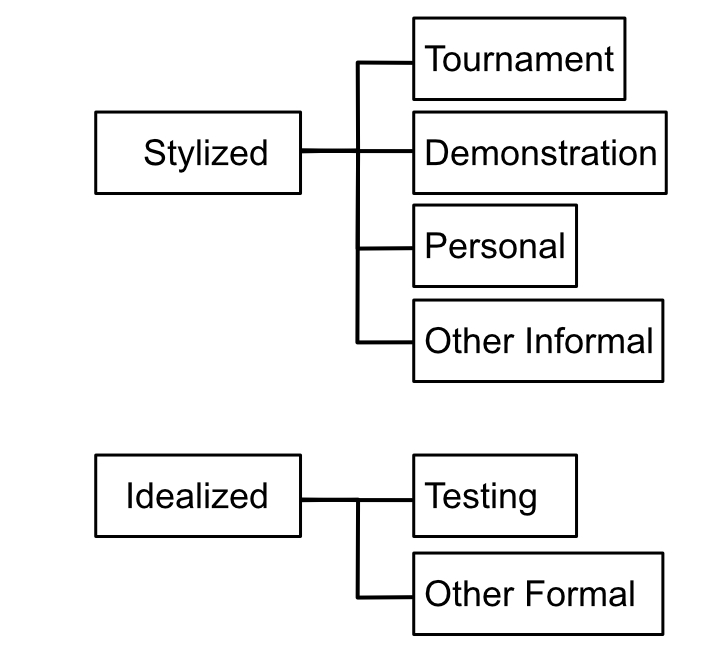There is one more important subject that must be discussed before actually getting into illustrating the execution of Form Four. This topic is execution style. Execution style can loosely be defined as the manner in which a form is carried out. Another way to look at it is, under what pretext is the form being performed? Or yet another is, for whom is the form being executed?
So, the form can be performed differently under different scenarios and circumstances. Why does this even matter?
Situation matters because the intent of the execution and/or the context of the performance can dramatically alter how the form is not only performed, but how it is received and perceived, along with what and how that performance conveys itself to the observers. For instance, would one perform the form differently if they were within a testing environment, compared to a tournament environment, or even a demonstration environment? In almost all cases the answer would be yes. And, the performance would also be viewed and scrutinized differently within each scenario by any observers.
Given these parameters, the execution of any form can typically be broken down into two (2) major styles: Idealized and stylized. Idealized being the strict, "standard" execution of the form, and stylized being the informal execution of the form.
In stylized execution; modifications, personalization, and enhancements would typically be readily accepted or encouraged. In short, this is to be expected, and the salutation even provides for this scenario.
This is in direct contrast to idealized execution. In this scenario anything other than the "standard" would typically be far less tolerable. Any personalization or modifications to the form's execution would be highly discouraged, or even penalized.
Another quick way to think about these two (2) opposing styles is: formal vs informal. And, each of these execution styles has an appropriate purpose and place. But it is important to understand each and how it influences the outcome of form execution.

Execution Style
Idealized execution is the easiest to characterize. This style exemplifies the strict, formal execution of the form. Another way to look at it is that the idealized style is the way the form "should" be executed - without any modifications and performed in the manner an American Kenpo purist would expect the form to be performed. In other words, performed in an ideal manner. The anticipated audience would most typically be individuals with knowledge of the form and the system. And, the execution would typically be tailored to elicit a positive response in regards to the performance's "correctness" and proper execution from a knowledgeable American Kenpo observers' perspective. Typical observers might be, an instructor, a testing board, peers, or others within the system.
Stylized execution would cover any other manner of form performance. This covers a vast range of informal scenarios. But the major difference lies in the fact that personal modifications, preferences, and tastes influence the execution of the form. It is also understood by "those in the know" that the form is purposely being performed with additions, subtractions, or changes. And, the execution might be tailored to create a positive response to other martial artists outside the system or just an audience of non-martial artists. Regardless of the audience, the performance is just that, a performance.
As stated earlier, stylized execution is of such accepted and encouraged importance that it is even physically built into the salutation. This oft overlooked salutation variation makes it easy to inform the observer(s) whether the execution of the form will be idealized or stylized - without speaking. For more information, refer to the "Variations" section of the "Salutation" chapter of this guide.
So, why is a discussion about execution style important enough to get its own section in this book? Because stylized execution can sometimes morph into idealized execution. This may be inadvertent or purposeful, but once this is done it can permanently change a form, in respects to that practitioner and their lineage, and potentially even the system. Because of this issue, one should always remain aware of these two styles and cognizant of which one they are presenting, while remaining fully capable of performing the form in either style, at will.
The reader should take special notice of what is not being said. Stylized execution is not being discouraged in any. The purpose of this text is to highlight the problems that may inadvertently arise when one does not understand the concepts presented here. It is to discourage the conflating of stylized execution with idealized execution. They both do and should exist co-equally within one's training.
One should, and is encouraged, to use stylized execution for exploration, personalized performance enhancement, or simply for enhanced viewer enjoyment. What should not be done is then fold that stylized execution back into the "standard" execution of the form.
And further, an instructor should encourage their student to develop their own stylized execution. Using the instructor's personal stylized execution as only a potential start. But making it extremely clear that this type of execution is stylized, not idealized, and ensuring the student has a good understanding of the difference. Otherwise, the warnings spelled out in this guide will most assuredly begin to take root and spread.
Finally, keep in mind that this book concentrates on the idealized style of execution. That is its intended purpose. It does not delve into the stylized aspects of execution any further than what is laid out in this section. Therefore, It is left up to the reader to further explore this style of execution outside the confines of this text.